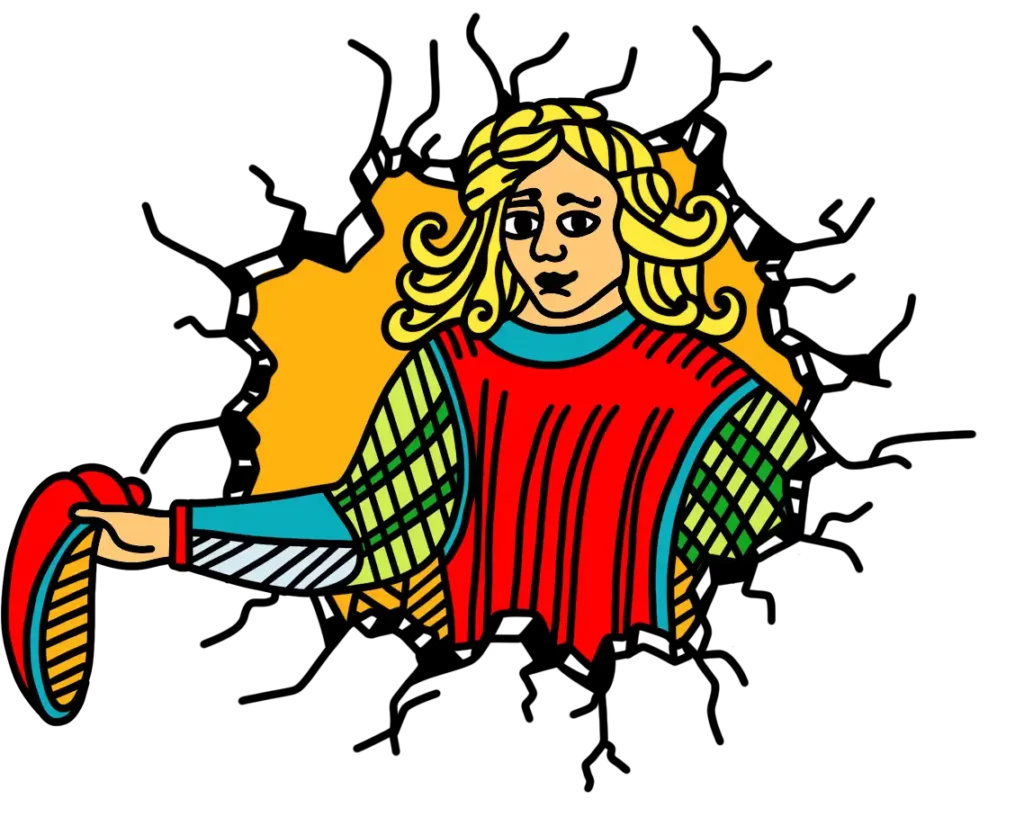
“The future torments us, the past holds us back, that’s why the present escapes us.”
The name of this card is called “l’instant présent” in French. It can be translated as “the present time” in English. If you notice any translation errors in this article, please let us know for our entire community. You can leave your comment at the bottom of this page.

The arcana of the present moment is centralized on the “here” and “now”. The quest for the present moment is a fascinating subject which combines both the notion of passing time and that of eternity, but also of the repetition of our actions. To evoke this idea, the arcana of the present moment includes several details, notably the symbols of the hourglass, the Ouroboros, the clock, the Latin divinity, “Janus”, the hat in the shape of infinity , a skull, and as well as the position of our character’s feet and finger.
The hourglass, as you know, is an object which measures time using the sand which flows from one part of the hourglass to the other. It thus represents the notion of time which It flows inexorably, like sand flowing from one place to another. But, on the other hand, the hourglass can also symbolize the present moment, because it reminds us that time is never frozen and that each moment is unique and precious. Likewise, a hourglass which would be overturned reminds us, thatour previous actions have an impact in our present. On the other hand, the Ouroboros is an ancient symbol which representsa serpent or a dragon which bites itself the tail, thus forming a perfect circle. It symbolizeseternity, infinity and the cycle of life. Indeed, the Ouroboros is often associated with the notion of < strong>rebirth,because it reminds us that everything that dies can be reborn in a new form. This snake recalls the notion of the endless cycle of life.
And how can these two symbols be linked to the present moment? Well, the present moment is like a point between two worlds, a point that is both in the past and in the future. Like the sand that flows in the hourglass, the present moment is fleeting and ephemeral, but it is also unique and precious. Like the Ouroboros, the present moment is also a symbol of eternity, because it reminds us that each moment is an opportunity to start again, to renew our life, to be reborn. In short, the present moment is a crucial moment that allows us to connect to the past and the future, to become aware of the eternity that surrounds us and to grasp the importance of each unique moment. . The hourglass and the Ouroboros are two symbols that remind us of the fragility of time and the eternity of the present moment. So let’s take advantage of every moment that is given to us, because it is as precious as the sand that flows into an hourglass, and as eternal as the snake that bites its tail.
A different vision could also be provided. The present does not exist! It is a conception of the mind, so life is in perpetual movement and nothing can be fixed. Only the human mind freezes things in order to understand them. This perpetual movement links the past and future, in a cause and effect relationship, where the present is only an image of our mind in order to understand the mechanism of life.The wheel turns and cannot be stopped. The double-faced character represents “Janus” who is a fascinating Roman god, known for his ability to look simultaneously into the past and the future. With his two faces, the one facing backwards and the other facing forward, Janus symbolizes transition, change and duality. The name Janus derives from the Latin “ianua”, which means ” door”.As the god of doors and passages, Janus was often depicted in Roman art as a door with two faces. According to Roman mythology, the doors of the Temple of Janus were meant to remain open in times of war and closed in times of peace, symbolizing the transition between the two states. Janus was also considered the god of beginnings, making him particularly important during New Year celebrations.In fact, the month of January takes its name from Janus, which shows how important this god was to the Romans. But Janus is otherwise a symbolof duality and contradiction. Looking simultaneously to the past and the future, he symbolizes the tension between opposing forces that coexist within ourselves and in the world. It represents the ability to move between worlds, transcend limitations and overcome obstacles. Janus is therefore a complex and fascinating god, who symbolizes at the same time transition, duality and the potentiality to transcend limits. By examining his myth and his symbols, we can be inspired to overcome our own obstacles and to embrace life’s transitions with confidence and determination.
Transition
Savor
Duality
Contradiction
Hope
Souvenir
Potential
Live
Be
Endless cycle
Eternity
Effect of our past actions
Looking to the future
Beginning
Gate / Portal


